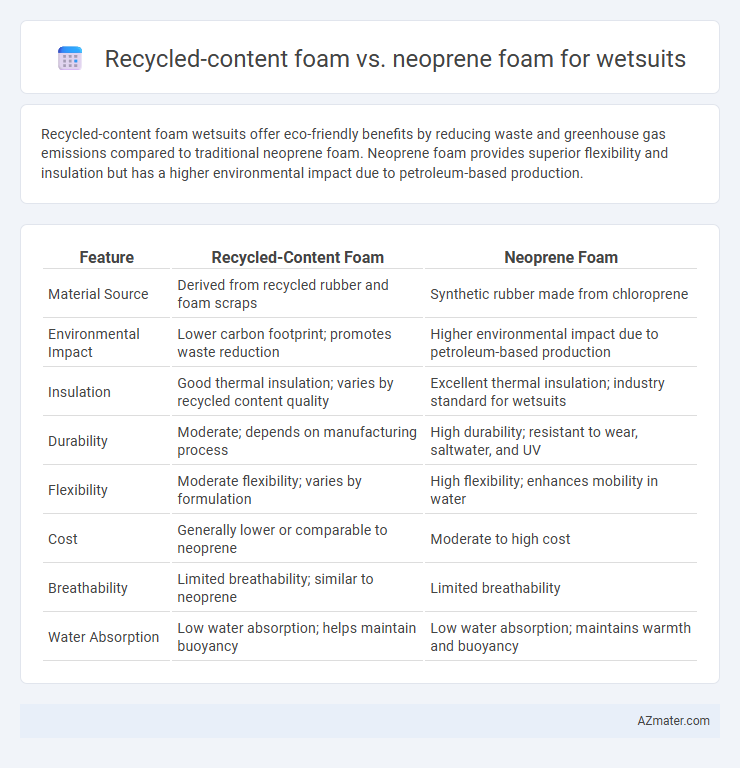Recycled-content foam wetsuits offer eco-friendly benefits by reducing waste and greenhouse gas emissions compared to traditional neoprene foam. Neoprene foam provides superior flexibility and insulation but has a higher environmental impact due to petroleum-based production.
Table of Comparison
| Feature | Recycled-Content Foam | Neoprene Foam |
|---|---|---|
| Material Source | Derived from recycled rubber and foam scraps | Synthetic rubber made from chloroprene |
| Environmental Impact | Lower carbon footprint; promotes waste reduction | Higher environmental impact due to petroleum-based production |
| Insulation | Good thermal insulation; varies by recycled content quality | Excellent thermal insulation; industry standard for wetsuits |
| Durability | Moderate; depends on manufacturing process | High durability; resistant to wear, saltwater, and UV |
| Flexibility | Moderate flexibility; varies by formulation | High flexibility; enhances mobility in water |
| Cost | Generally lower or comparable to neoprene | Moderate to high cost |
| Breathability | Limited breathability; similar to neoprene | Limited breathability |
| Water Absorption | Low water absorption; helps maintain buoyancy | Low water absorption; maintains warmth and buoyancy |
Introduction: The Evolution of Wetsuit Materials
Recycled-content foam and neoprene foam represent significant advancements in wetsuit materials, reflecting the industry's shift toward sustainability and performance. Recycled-content foam utilizes repurposed materials to reduce environmental impact without compromising thermal insulation and flexibility vital for aquatic activities. Neoprene foam, traditionally favored for its durability and excellent buoyancy, continues to evolve with eco-friendly manufacturing processes that balance functionality and environmental responsibility.
What is Recycled-Content Foam?
Recycled-content foam used in wetsuits is made from repurposed rubber and neoprene materials, reducing environmental impact by diverting waste from landfills. This foam retains key properties like flexibility, insulation, and durability comparable to traditional neoprene foam, making it an eco-friendly alternative for water sports enthusiasts. Brands incorporating recycled-content foam emphasize sustainability without compromising wetsuit performance or comfort.
What is Neoprene Foam?
Neoprene foam is a synthetic rubber material known for its excellent insulation, flexibility, and durability, making it the primary choice for wetsuit construction. It features closed-cell bubbles that trap air, offering superior thermal protection in cold water environments. Compared to recycled-content foam, neoprene provides enhanced stretch and resistance to water absorption, ensuring optimal comfort and performance during aquatic activities.
Environmental Impact: Recycled-Content vs Neoprene
Recycled-content foam wetsuits significantly reduce environmental impact by utilizing post-consumer materials and lowering reliance on petroleum-based neoprene, which is energy-intensive to produce and non-biodegradable. Neoprene foam contributes to greenhouse gas emissions during manufacturing and poses disposal challenges due to its long degradation period. Choosing recycled-content foam supports circular economy principles and minimizes carbon footprint without compromising wetsuit performance.
Performance and Flexibility Comparison
Recycled-content foam for wetsuits offers comparable thermal insulation and buoyancy to neoprene foam while significantly reducing environmental impact by utilizing sustainable materials. Neoprene foam remains superior in flexibility and durability, providing enhanced stretch and resilience under extended use and varying water conditions. Performance-wise, recycled-content foams are improving rapidly but currently may exhibit slightly less elasticity and compressive strength than traditional neoprene foams.
Durability and Longevity Factors
Recycled-content foam in wetsuits offers comparable durability to neoprene foam but excels in sustainability by reducing environmental impact through repurposed materials. Neoprene foam is known for superior resistance to compression, UV degradation, and chemical exposure, ensuring longer-lasting elasticity and performance in extreme conditions. Both materials' longevity depends on factors like thickness, use frequency, and care, with neoprene generally providing a higher lifespan in professional and high-intensity water activities.
Comfort and Fit: User Experience
Recycled-content foam wetsuits offer enhanced breathability and flexibility, allowing for a more comfortable fit during extended water activities. Neoprene foam provides superior stretch and snugness, creating a form-fitting seal that reduces water entry and improves thermal insulation. Users often report that recycled-content foam wetsuits feel lighter and more environmentally friendly, while neoprene excels in providing a secure, performance-driven fit ideal for diverse water conditions.
Cost Analysis: Initial Investment and Long-Term Value
Recycled-content foam wetsuits typically have a lower initial investment compared to neoprene foam, making them attractive for budget-conscious consumers. Neoprene foam offers superior durability and thermal insulation, which translates to greater long-term value despite the higher upfront cost. Evaluating total cost of ownership, including replacement frequency and performance, highlights the cost-effectiveness of neoprene foam in demanding conditions.
Brand Choices and Industry Adoption
Recycled-content foam is gaining traction among eco-conscious wetsuit brands like Patagonia and Outerknown, emphasizing sustainability without compromising performance. Neoprene foam remains the industry standard favored by established companies such as O'Neill and Rip Curl due to its durability and flexibility. Emerging startups often blend recycled foam with neoprene to appeal to environmentally aware consumers while maintaining traditional wetsuit qualities.
Future Trends in Eco-Friendly Wetsuit Materials
Recycled-content foam and neoprene foam represent key materials in the evolution of eco-friendly wetsuits, with recycled-content foam gaining traction due to its reduced environmental impact and sustainable sourcing. Innovations are driving enhanced durability and flexibility in recycled foams, matching neoprene's performance while lowering carbon footprints and chemical usage in production. Future trends point toward increased adoption of bio-based and closed-loop recycled foams, accelerating the transition to fully sustainable wetsuit materials without compromising comfort or functionality.

Infographic: Recycled-content foam vs Neoprene foam for Wetsuit
 azmater.com
azmater.com